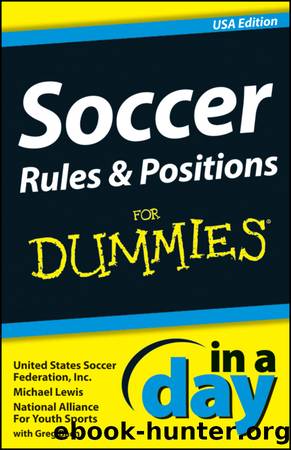Soccer Rules and Positions In a Day For Dummies by Michael Lewis

Author:Michael Lewis
Language: eng
Format: epub
Publisher: Wiley
Published: 2012-06-04T00:00:00+00:00
Diagram by Wiley, Composition Services Graphics
Figure 3-2: This attacker is onside, due to the positions of the defender and goalie when the ball was played.
Offside doesnât apply to goal kicks, throw-ins, or corner kicks (though it does apply to direct and indirect free kicks, penalty kicks, and goalie clearing kicks and throws). And offside is never called at the defensive end of the field. Players can be whistled for this infraction only when theyâre on the opponentâs half of the field.
Penalty Calls and Their Results
In the sections that follow, we give you all the information you need to understand when fouls or other violations occur. Soccer has major and minor fouls that result in the opposing team taking an indirect free kick, direct free kick, or penalty kick. Donât worry â we cover each of the categories and kicks in the sections that follow and help you get a handle on those pesky yellow and red cards.
Outlining the major fouls
Nine major fouls result in the opposing team receiving a direct free kick. These major fouls are especially troublesome when committed within the penalty area, because the resulting penalty kick is a shot on goal with only the goalie defending (see the âPaying the price for foulsâ section, later in the chapter, for more on penalty kicks). Take a look at the major fouls:
Handball: Soccer is played primarily with the head, chest, legs, and feet â not the hands. This rule is one of the most basic rules of soccer. Besides the goalie, who can use his hands within the confines of the penalty area, no other players can touch the ball with their hands in the field of play. Any player, not counting the goaltender, who intentionally touches the ball with her hand or arm to gain control of the ball is whistled for a handball, and the opposing team takes possession of the ball.
Kicking: Kicking an opponent, or attempting to kick him, is a big no-no.
Tripping: The referee calls this foul after a player takes out the attacking playerâs legs instead of knocking the ball away.
Jumping: This infraction involves jumping or lunging at a player and most often is called when an opposing player or the goalie is in the air making a play on the ball.
Charging: Referees signal charging when a player charges into an opponent with an intent to harm. If the player makes a play on the ball and the contact is incidental, charging doesnât apply.
Charging from behind: A player may never knock an opponent to the ground by charging from behind.
Striking: Any attempt to strike an opponent, or the actual striking of an opponent, is never allowed. This transgression includes intentionally throwing the ball at an opposing player.
Holding: Players canât grab an opponentâs jersey to slow her down or stick out their arms to obstruct the playerâs movement in any way.
Pushing: Players canât push, shove, or nudge an opponent in an effort to gain any type of advantage.
Download
This site does not store any files on its server. We only index and link to content provided by other sites. Please contact the content providers to delete copyright contents if any and email us, we'll remove relevant links or contents immediately.
Futebol by Alex Bellos(1801)
No Hunger In Paradise by Michael Calvin(1565)
Pep Confidential by Martí Perarnau(1492)
Sir Matt Busby by Patrick Barclay(1285)
The Game of Our Lives by David Goldblatt(1237)
Cyrille Regis: My Story by Cyrille Regis(1235)
ALEX FERGUSON My Autobiography by Alex Ferguson(1223)
Football's Strangest Matches by Andrew Ward(1199)
No Nonsense by Joey Barton(1180)
The Lost Boys by Ed Hawkins(1149)
Cristiano Ronaldo: The Biography by Guillem Balague(1141)
Angels with Dirty Faces by Jonathan Wilson(1131)
Red Card by Ken Bensinger(1101)
Soccer Men: Profiles of the Rogues, Geniuses, and Neurotics Who Dominate the World's Most Popular Sport by Simon Kuper(1032)
We Are the Damned United by Phil Rostron(975)
A Season With Verona by Tim Parks(973)
Scholes : My Story (9781471125799) by Scholes Paul(950)
Eight World Cups by George Vecsey(921)
50 Complete Goalkeeping Training Sessions by Hageage Tamara Browder(916)
